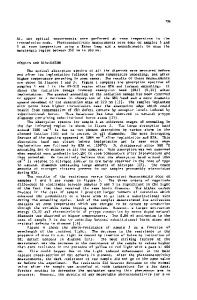MeV Ion Implantation Doping of Diamond
- PDF / 208,963 Bytes
- 10 Pages / 612 x 792 pts (letter) Page_size
- 97 Downloads / 447 Views
MeV Ion Implantation Doping of Diamond. S. Prawer, D.N. Jamieson, K.W. Nugent, and R. Walker, C. Uzan-Saguy1 and R. Kalish1 School of Physics, University of Melbourne, Parkville, Victoria, 3052, Australia 1 Solid State Institute and Physics Department, Technion, Haifa, 32000, Israel.
ABSTRACT Diamond-based semiconductor devices offer the promise of operation at high temperatures and under extreme radiation conditions. An essential step in the drive towards operational diamond-based electronic devices is the ability to controllably and reproducibly dope the diamond. Ion implantation is the method of choice for such doping because it offers precise control of the dopant concentration and spatially selective doping is achievable using standard masking techniques. However, compared to silicon, the doping of diamond is complicated by the tendency of the diamond to relax to graphite upon thermal annealing. Furthermore, even if graphitization can be avoided, the compensation of dopants by residual defects has proved in the past to be a limiting factor in obtaining very high mobility material. In this paper, we present a scheme for the effective doping of diamond using MeV ion-implantation. For MeV ionimplantation the doped layer is deeply buried under a cap of undamaged diamond, and so the scheme includes a method using pulsed laser irradiation for making electrical contact to the buried layer. We show that a boron doped layer fabricated by the MeV implantation scheme has, after suitable annealing and removal of these compensating/trapping defects, very high mobility and low compensation ratio. In fact, its electrical properties are quite similar to those of natural boron-doped type IIb diamond. INTRODUCTION Diamond is an extreme material. It boasts the highest atomic density, thermal conductivity and hardness of any material known to man. It is optically transparent over a wide range of wavelengths from the infra-red to the ultraviolet. It has a large band-gap (5.5 eV) and may be considered to be the prototype wide-band gap semiconductor. To date diamond has been considered for a wide range of applications, including the obvious mechanical applications such as cutting tools, ultrasharp knives and high pressure anvils; optical applications especially as ultrathin, ultrastrong transparent windows and membranes, and as a passive heat sink and spreader for semiconductor devices (especially lasers). However, perhaps the most exciting application is its potential use in radiation-hard, high-power, high-temperature active semiconductor devices. To take advantage of the superb properties of diamond in such devices, the problem of doping diamond must be solved. Ion Implantation has become the method of choice for the doping of semiconductors in a wide variety of applications because it offers spatial and depth control not achievable using diffusion or growth methods. However, following the implantation the radiation damage must be O4.3.1
annealed in order to activate the dopants. The main challenge to the ion implantation dopin
Data Loading...










